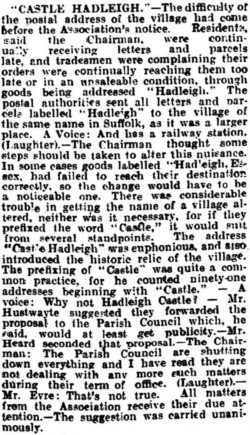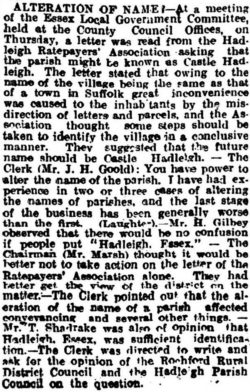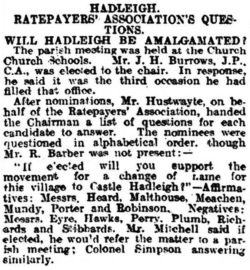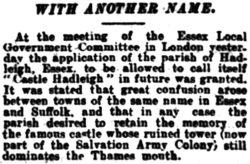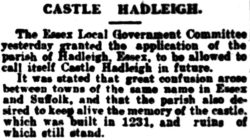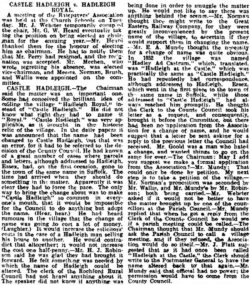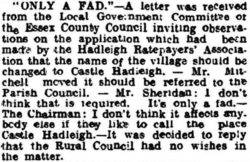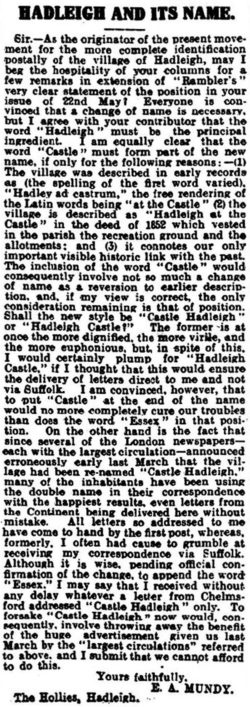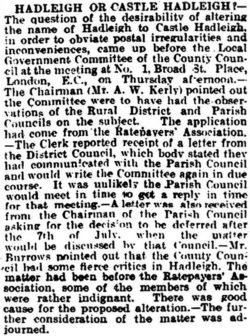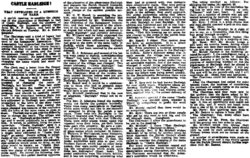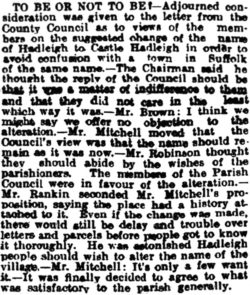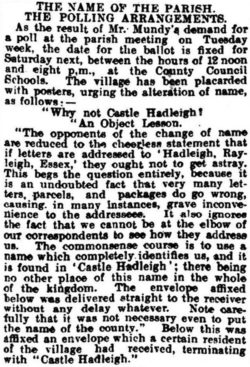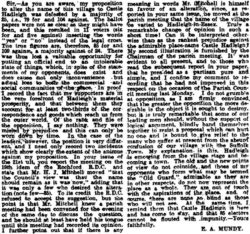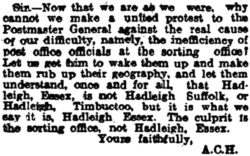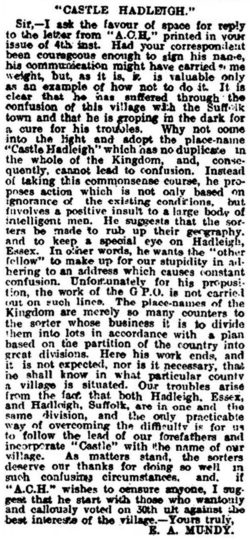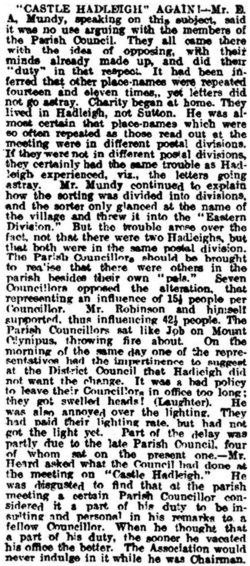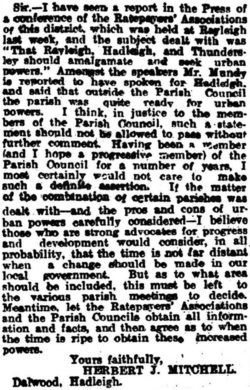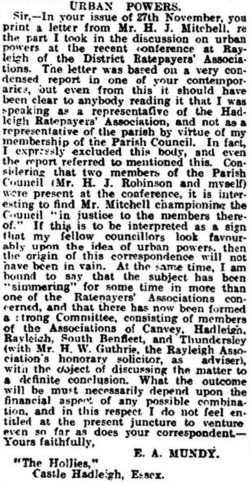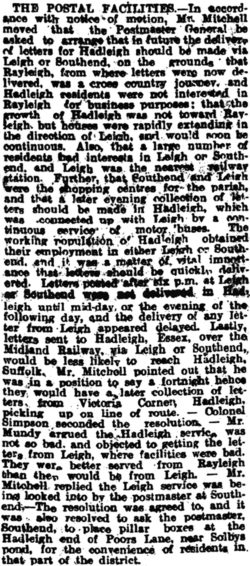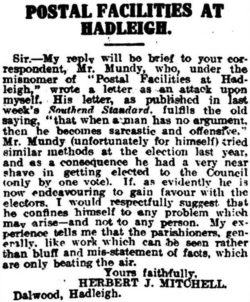A Tale of Two Hadleighs
Hadleigh in Essex was first named Haeþlege c.1000, derived from the Saxon for heath clearing. Over the next few hundred years, the spelling changed many times, with the addition of Kyngeshadlegh in 1289 (Kings Hadleigh) and Hadley ad Castrum in 1551 (Hadleigh at Castle). It is situated about 37 miles from Hadleigh in Suffolk, and a century ago both places were in the same postal district. This caused some confusion with the postal service, leading to items meant for Hadleigh in Essex being at first delivered to Hadleigh in Suffolk as it was the larger town, before making their way to their correct recipients.
In Jan 1913, outspoken local Councillor Edgar Arthur Mundy and current Chairman of the Hadleigh Ratepayers’ Association, began a debate regarding Hadleigh’s post. It was not common practice to include the county when addressing a letter or parcel at the time and would be several decades before postcodes were introduced nationwide (from 1959). Councillor Mundy’s solution was to change the name of the village to “Castle Hadleigh”, to reflect its castle ruins and historical past and clearly define it from Hadleigh in Suffolk. The suggestion was carried and the proposal was forwarded to the Parish Council. News of this made its way to newspapers in both Wiltshire and Kent.
Newspaper articles throughout reproduced with the permission of the British Newspaper Archive and The British Library Board.
- Southend Standard and Essex Weekly Advertiser – Thursday 16 January 1913
- Swindon Advertiser – Monday 20 January 1913
A meeting was held on 6th Mar 1913 of the Essex Local Government Committee at the County Council Offices where the letter from the Hadleigh Rate Payers Association regarding changing the name of Hadleigh was read. The committee had sufficient power to alter the name but decided it best to ask the opinions of Rochford District Council and Hadleigh Parish Council first. Later that month there was another meeting of the Hadleigh Ratepayers’ Association, this time John H Burrows was elected to chair. The question was put to the nominees, with even numbers for and against.
- Southend Standard and Essex Weekly Advertiser – Thursday 13 March 1913
- Southend Standard and Essex Weekly Advertiser – Thursday 20 March 1913
By this time news of the Hadleigh name-change debate had travelled up and down the country, reaching newspapers in Bristol, London, Leicester and even Manchester. All printed in error that Hadleigh had been granted permission to change its name to Castle Hadleigh.
- Clifton Society – Thursday 13 March 1913
- Leicester Evening Mail – Friday 07 March 1913
- Daily Citizen (Manchester) – Friday 07 March 1913
- Daily News (London) – Friday 07 March 1913
- Evening News (London) – Friday 07 March 1913
A local newspaper article by “Rambler” in Apr 1913 mentioned there were now three alternative names being considered: Hadleigh Royal, Castle Hadleigh and Hadleigh Castle. The next meeting of the Hadleigh Ratepayers’ Association on 13th May 1913 discussed this matter, and was also noted that the daily papers had published the name had already been changed even though it had yet to go to the County Council. On reading about the situation at Hadleigh, the Rural Council dismissed it as “only a fad” and had no further interest in the matter, whilst Councillor Mundy confirmed his next step was to take a petition of the village.
- Southend Standard and Essex Weekly Advertiser – Thursday 03 April 1913 (Rambler)
- Social Gazette (London) – Saturday 10 May 1913
- Southend Standard and Essex Weekly Advertiser – Thursday 15 May 1913
- Southend Standard and Essex Weekly Advertiser – Thursday 22 May 1913 (Rambler)
- Southend Standard and Essex Weekly Advertiser – Thursday 29 May 1913
- Southend Standard and Essex Weekly Advertiser – Thursday 29 May 1913 (Rambler)
In Jun 1913, Councillor Mundy replied to “Rambler’s” column of 22nd May making clear why he thought the change of name the Castle Hadleigh was so important. He also pointed out that since the London papers had mistakenly printed the name had already changed in March (followed by other newspapers into May), many letters were now being addressed as such and making their way to Hadleigh without going via Suffolk first.
On 5th Jun the issue came before the Local Government Committee of the County Council in London, but due to not having all the relevant communications from the Rural District and Parish Council on the subject the matter was adjourned until the next month’s meeting. When the Local Government Committee of the County Council met again in Jul 1913 they requested the Council’s input and transferred the matter to the Parish Council.
- Southend Standard and Essex Weekly Advertiser – Thursday 05 June 1913
- Southend Standard and Essex Weekly Advertiser – Thursday 12 June 1913
- Southend Standard and Essex Weekly Advertiser – Thursday 10 July 1913
The next parish meeting was held on 19th Aug 1913 and discussed the proposal in much more depth, including statistics concerning the repetition of other place names within England. The newspaper article printed made it clear that Councillor Mundy and Councillor Herbert John Mitchell were of opposing ideas, something which reared many times. On voting, 18 were for a change of name whilst 20 were against. Councillor Mundy demanded a poll to resolve the issue, not wanting it to be settled by a majority of just two.
The poll was set for 30th Aug, and the village was covered with posters stating:
“Why not Castle Hadleigh?
“An Object Lesson.“The opponents of the change of name are reduced to the cheerless statement that if letters are addressed to “Hadleigh, Rayleigh, Essex, ” they ought not to get astray. This begs the question entirely, because it is an undoubted fact that very many letters, parcels, and packaged do go wrong, causing in many instances, grave inconveniences to the addressees. It also ignores the fact we cannot be at the elbow of our correspondents to see how they address us. The commonsense course is to use a name which completely identifies us, and it is found in “Castle Hadleigh”: there being no other place of this name in the whole of the kingdom. The envelope affixed below was delivered straight to the receiver without any delay whatever. Note carefully that it was not necessary even to put the name of the county.”
The results came back as 79 for and 104 against, with a majority win of 25 to keep Hadleigh named as such. Councillor Mundy addressed the people waiting around the gates afterwards to thank them for voting, adding “don’t forget that Castle Hadleigh as a name is here and no one can alter it.”
- Southend Standard and Essex Weekly Advertiser – Thursday 21 August 1913
- Southend Standard and Essex Weekly Advertiser – Thursday 21 August 1913
- Southend Standard and Essex Weekly Advertiser – Thursday 28 August 1913
- Southend Standard and Essex Weekly Advertiser – Thursday 04 September 1913
- Southend Standard and Essex Weekly Advertiser – Thursday 04 September 1913
This was not to be the end of the matter however, as shown by Councillor Mundy’s letter to the local paper printed in early Sep 1913. Councillor Mitchell was mentioned several times, and none too favourably! A letter was also printed by “A. C. H.”, who blamed entirely the sorting office for the problem with Hadleigh’s post going wrongly to Suffolk. Councillor Mundy would hear no such thing, being determined still that the only solution was a name change. Councillor Mundy continued to talk about the subject at the next Hadleigh Ratepayers’ Association. A reply was finally received from the Great Eastern Railway Company to say they were in favour of the name change, although too late to add any sway.
- Southend Standard and Essex Weekly Advertiser – Thursday 04 September 1913
- Southend Standard and Essex Weekly Advertiser – Thursday 04 September 1913
- Southend Standard and Essex Weekly Advertiser – Thursday 11 September 1913
- Southend Standard and Essex Weekly Advertiser – Thursday 11 September 1913
- Southend Standard and Essex Weekly Advertiser – Thursday 11 September 1913
In Dec 1913 Councillor Mundy wrote a letter (from “Castle Hadleigh, Essex”) to the local newspaper about another letter printed the previous Nov from Councillor Mitchell. Councillor Mundy made it clear he had still not given up on the idea of Castle Hadleigh and had formed a “strong committee” consisting of members from Canvey, Hadleigh, Rayleigh, South Benfleet and Thundersley with a view to discussing the matter “to a definite conclusion“.
- Southend Standard and Essex Weekly Advertiser – Thursday 27 November 1913
- Southend Standard and Essex Weekly Advertiser – Thursday 04 December 1913
There are no further newspaper articles mentioning any additional meetings about the proposed name change, but it is clear that Councillor Mundy was still championing the idea into early 1914, as well as the grudge he and Councillor Mitchell held for each other, whilst discussing the postal service to Hadleigh.
WWI began in Jul and put an end to talk of “Castle Hadleigh”, and the subject was never broached again.
- Southend Standard and Essex Weekly Advertiser – Thursday 05 March 1914
- Southend Standard and Essex Weekly Advertiser – Thursday 26 March 1914
- Southend Standard and Essex Weekly Advertiser – Thursday 09 April 1914
- Southend Standard and Essex Weekly Advertiser – Thursday 16 April 1914
Edgar Arthur MUNDY was born in 1875 in Highgate, London. As well as being a local councillor for Hadleigh, he was also an Australian Merchant’s Buyer. Edgar married Lillian Elizabeth PHILLIPS in Jan 1896 in the St. Pancras district but divorced in 1899. It would seem Lillian left her husband in the May of 1869 never to return, and Edgar petitioned for the dissolution of the marriage due to adultery later partaken. He then married Amy TANNER in 1900 in the St. Pancras district. They had two daughters, Joan Olive MUNDY born in 1908 in Southend-On-Sea, and Barbara Victoria MUNDY 1913 in Hadleigh. The family lived at The Hollies on Rectory Road, Hadleigh for many years and when the 1939 Register was taken Edgar was still working as an Australian Merchant’s Buyer at age 64. Both Edgar and Amy died in 1965, Amy age 90 on 6th Jun at 69 Rectory Road (The Hollies is now no.41 and the site of the local doctor’s surgery), and Edgar also age 90 on 21st Dec at Bishops Cleeve near Cheltenham in Gloucestershire (possibly at daughter Barbara’s residence). Their daughter Joan sadly died just before her parents at age 50 in 1958, whilst Barbara died at age 79 in 1992 in Cheltenham.
Herbert John MITCHELL was born in 1873 in Poplar, London. Herbert married Lizzie BATSTONE in 1898 in Devon, where Lizzie was born. Daughter Marion Batstone MITCHELL was born 1901 in Norwood, Surrey, and son Leslie Herbert MITCHELL was born 1905 in Hadleigh, Essex. As well as being a local councillor for Hadleigh, Herbert worked as an India Rubber Manufacturer’s Agent. The family lived at “Dalwood” on Church Road, Hadleigh until 1925 when they moved. Herbert died in 1938 in Hutton Park, Essex age 65, and Lizzie (as Bessie Lizzie) died in 1952 in Gidea Park, Essex age 76.

